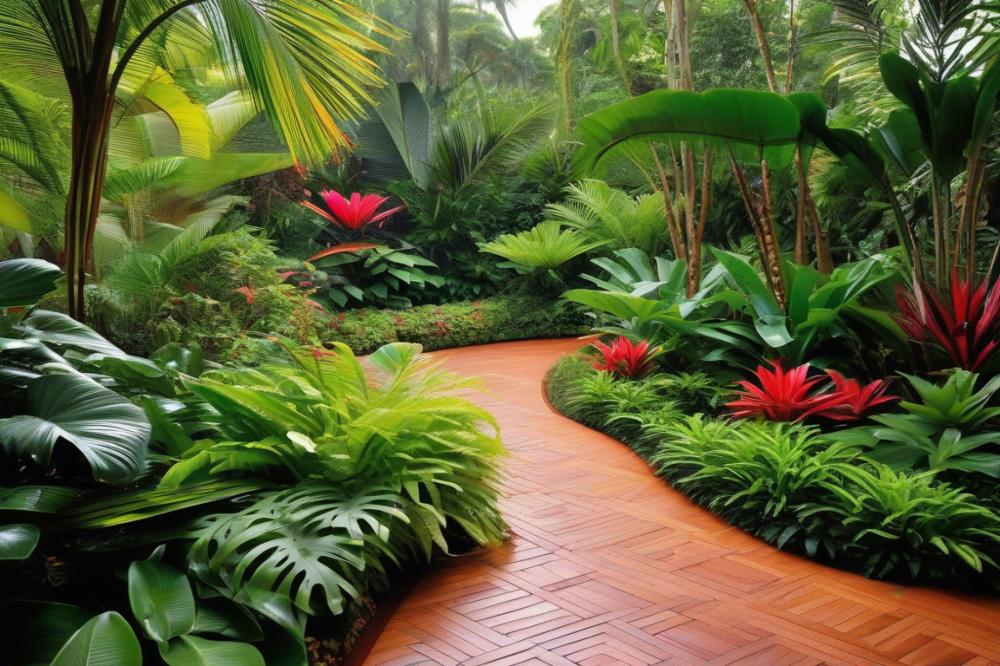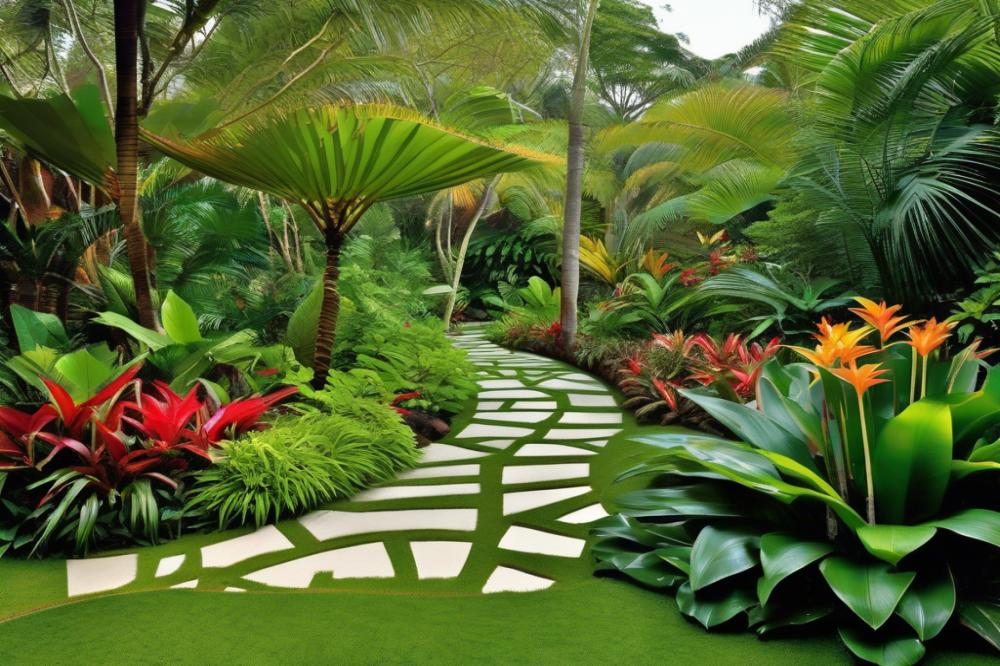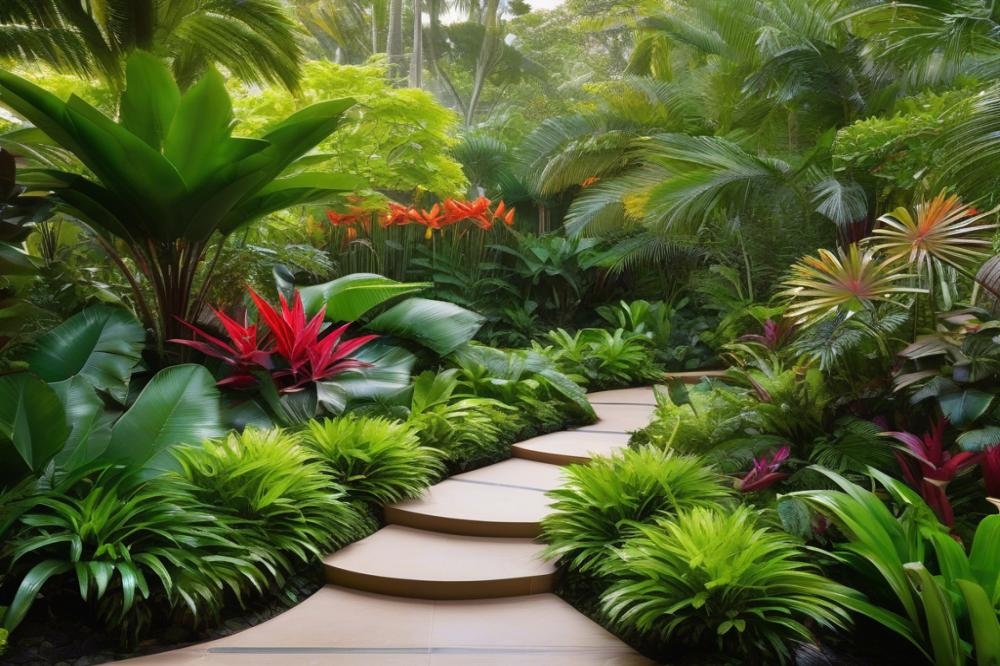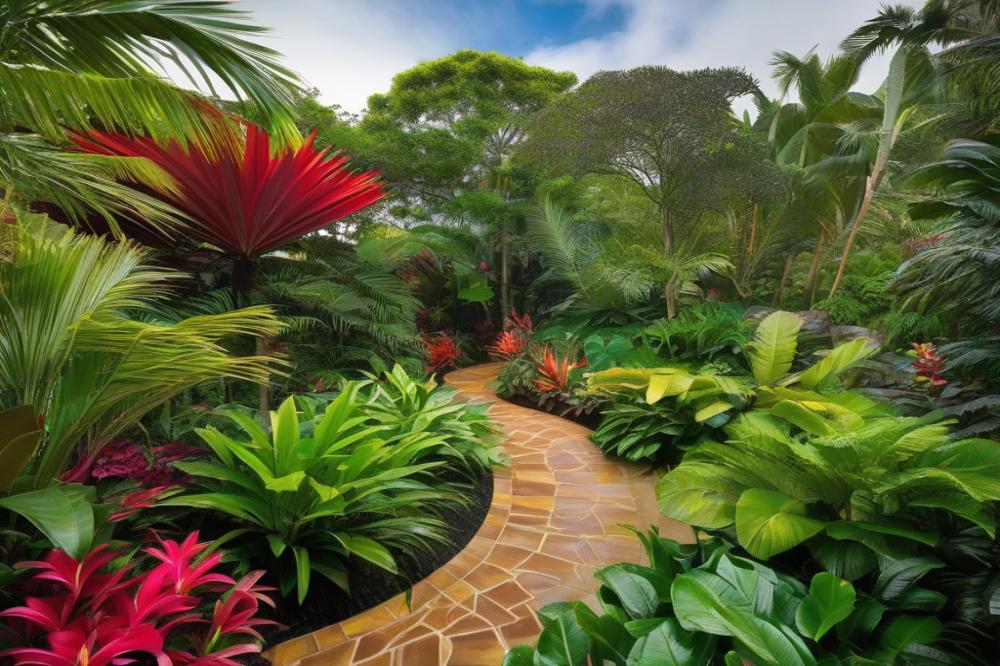Introduction to Designing Pathways for an Exotic Garden Experience
Creating an enchanting space often starts with the right planning. Exotic Garden Design stands out by blending vibrant colors, unique plant life, and inviting pathways. Pathways serve a crucial role in guiding visitors through this captivating environment. They enhance the overall experience by offering easy navigation and a sense of adventure.
Every detail in a garden layout can influence how visitors interact with the landscape. Thoughtful placement of pathways improves outdoor aesthetics while showcasing tropical plants. Select pathway materials that complement the flora around them. This choice goes beyond looks; it impacts garden maintenance and longevity. Eco-friendly design elements can also contribute to a sustainable approach.
As seasons change, the garden offers different displays. Pathways allow for a better appreciation of plant arrangements across the year. They provide visitors with a journey that unfolds naturally, revealing new sights at each turn. When pathways are well-designed, they become part of the experience—inviting exploration and relaxation.
landscape architecture plays a pivotal role in this process. Integrating pathways in the garden can transform a simple outdoor space into an immersive retreat. Create an exotic escape that captivates the senses. Give visitors the chance to enjoy nature’s beauty as they stroll through your Garden Pathways.
Understanding Exotic Garden Design


Exotic gardens transport visitors to distant lands, filled with vibrant colors and diverse plant life. These gardens stand out due to their unique features, often incorporating elements that feel like a tropical paradise. They frequently prioritize lush foliage, dramatic flowers, and a variety of textures, creating a sensory delight that captivates all who enter.
Definition and Characteristics of Exotic gardens
Such gardens typically reflect the principles of landscape architecture, often fusing various design elements. Tropical plants feature heavily, showcasing their ability to thrive in warm climates. Pathways may wind through dense foliage, offering an inviting exploration experience. Organic shapes and flowing lines dominate the layout, steering clear of rigid grid patterns. Seasonal changes also enhance the garden’s appeal, as different plants bloom at various times throughout the year.
Examples of Tropical Plants Used in These Gardens
Consider incorporating popular tropical plants such as hibiscus, bird of paradise, or monstera. These selections not only provide visual interest, but they also contribute to the overall garden atmosphere. Layering various heights in plant arrangements adds depth and intrigue. Visitors often appreciate the vibrant flowers of ginger and the striking leaves of elephant ear. Such choices elevate the garden’s outdoor aesthetics tremendously.
Influence of Cultural and Geographical Elements on Design
The design of an exotic garden is deeply influenced by cultural and geographical elements. Regional plants and traditional gardening styles play a significant role in shaping the overall vision. For example, plants native to Asia often require careful attention to garden maintenance, while those from South America may thrive with minimal care. Visitors can get a truly immersive experience as they encounter elements unique to specific cultures. Using eco-friendly design enhances sustainability in these gardens, making them appealing not just visually, but also responsibly.
Planning Pathways in an Exotic Garden


Strategic placement of pathways can create a beautiful flow. A smooth layout makes it easy for visitors to explore diverse areas. Think about how the paths connect different sections of your garden. People should feel drawn to each corner of the space. Plan for wide paths where gatherings can happen. Tight areas should encourage a sense of intimacy.
Incorporating Seasonal Changes into Pathway Design
Seasons play a big role in outdoor aesthetics. Design pathways that change with the garden throughout the year. Use materials that complement seasonal plants. During spring, vibrant flowers could line the path. In autumn, consider rich foliage as a backdrop. Visitors will appreciate seeing new sights every time they visit.
Consideration of Plant Arrangements Along Pathways
Think about how tropical plants will impact pathway design. Layering plants beside the paths provides texture. Taller plants can offer a glimpse into hidden spots. Shorter plants should enhance the pathway without blocking views. Balance is critical for attractiveness. Each arrangement needs to invite curiosity without overwhelming guests.
Garden maintenance is easier when plant arrangements are thoughtful. Keeping plants tidy creates a clean look. Pathway materials should complement greenery, too. Stones, gravel, or even wood can all serve as stunning options. Eco-friendly design can guide material choices. Use local options that blend seamlessly with nature.
Ultimately, your pathway design shapes visitor experience. Careful planning ensures spaces feel welcoming. A well-designed pathway leads the way to discovery in your garden. Prospective guests will remember the adventure, drawn back time and again.
Selecting Pathway Materials


Creating the right pathways for your garden sets the stage for an exotic garden experience. Various materials can enhance outdoor aesthetics while contributing to the overall feel of the landscape architecture. Popular options include stone, gravel, brick, and permeable pavers. Each choice has its own unique character and can greatly affect the garden layout.
Overview of Popular Materials for Exotic Pathway Design
Stone pathways exude a timeless charm. They can be made from slate or flagstone, presenting a rustic vibe that blends beautifully with tropical plants. Gravel is another option, offering flexibility in design and easy installation. Brick pathways add a touch of elegance, available in many colors and textures, allowing for distinct patterns. Pavers are practical too. They can withstand seasonal changes while being safe for foot traffic. A varied combination of these materials can captivate visitors and elevate the garden atmosphere.
Balancing Aesthetics with Functionality in Material Choice
Choosing the right materials can be tricky. You need to balance beauty with practicality. Consider how the materials will hold up against garden maintenance and weather elements. It’s essential for pathways to be durable and withstand heavy traffic. Picking the right texture can enhance safety as well. Smooth surfaces might be less forgiving during rainy days, while textured materials can provide better traction. Think about the colors too. Darker shades absorb heat, which might not be ideal under direct sunlight, especially in warmer climates.
Eco-friendly Material Options for Sustainable Design
Sustainable practices are vital for any garden project. Eco-friendly design shouldn’t be overlooked when choosing pathway materials. Recycled stone or reclaimed wood can add character while being good for the planet. Permeable pavers allow water to seep through, reducing runoff and supporting local ecosystems. Bamboo is an exciting choice as well. It’s incredibly strong, sustainable, and can complement tropical plants beautifully. When making these decisions, consider how they impact both the environment and your garden’s overall appeal.
Enhancing Outdoor Aesthetics


Creating Visual Interest Through Pathway Design
Pathways play a vital role in garden layout. They can transform plain spaces into visually striking areas. Different materials, like stone or mulch, can add texture. Each choice impacts the overall feel of your garden. Consider how colors will interact with tropical plants. This strategy creates a vibrant backdrop. Additionally, adding borders or edging can define the space. It helps in guiding visitors along a set journey. Mix different textures for a balanced look.
Using Curves and Lines to Guide the Eye
Straight lines offer a clean, formal appearance. Yet, curves often lend a more relaxed vibe. Use winding paths to create an inviting atmosphere. They draw the gaze gently through the landscape. This approach enhances the visitor experience. Curvature offers surprise and excitement. It can highlight seasonal changes beautifully, too. Sharp angles might work in some designs but should be used sparingly. The smooth transitions allow for natural flow in the garden.
Integrating Focal Points with Pathways
Every great garden has elements that catch the eye. Focal points can be sculptures, water features, or unique plant arrangements. Align pathways to lead visitors toward these highlights. This setup not only directs foot traffic, it also boosts outdoor aesthetics. The journey becomes part of the experience. Each step taken towards a focal point adds anticipation. Think about how vibrant blooms might be complemented by a nearby bench. Such elements encourage visitors to linger and appreciate nature.
Eco-friendly design can also play a part in pathway choices. Sustainable materials showcase a commitment to the environment. This decision enhances your garden’s appeal and ease of garden maintenance. Paths made from gravel or recycled materials can blend well with the surroundings. They maintain their charm while being practical. Make every inch count. Crafting a memorable garden involves more than just plants. It’s about creating spaces that invite exploration and delight.
Garden Maintenance and Pathway Care
Pathways in exotic gardens are essential for both functionality and beauty. It is important to select durable pathway materials that complement the garden layout. Stones, gravel, and pavers can enhance outdoor aesthetics while allowing visitors to explore. Regular garden maintenance keeps these walkways clear and inviting. Cleaning debris and removing weeds ensures that the pathways remain safe and accessible.
Seasonal changes affect the garden feel and require thoughtful upkeep. In spring, clear out leftover winter debris to welcome blooming tropical plants. Summer might require more frequent cleaning due to fallen leaves. During autumn, watch for leaves from trees that can clutter pathways. Winter maintenance focuses on preventing ice build-up in areas that see heavy foot traffic, thus ensuring safety.
Every detail impacts visitor experience. A well-maintained pathway invites individuals to take a closer look at the unique plant arrangements that surround it. Garden tours are more enjoyable when pathways are free of obstacles. Visitors often linger longer in spaces that are aesthetically pleasing and easy to navigate. A thoughtful combination of appropriate pathway material and vibrant plant life creates a welcoming atmosphere that encourages exploration.
Using eco-friendly design principles can enhance these garden features. Opting for sustainable materials and practices makes a positive impact on the environment. Mulching pathways, for instance, can reduce weed growth while retaining moisture for nearby tropical plants. This approach not only benefits the garden but also resonates with environmentally conscious visitors.
Planning for maintenance is as crucial as the initial landscape architecture. Keeping a regular schedule for pathway care prevents larger issues down the road. Consider hiring a professional or setting up a community effort for upkeep to share the responsibility. Every season brings its own set of challenges, but with proactive measures, the integrity of the garden remains intact.
Final Thoughts on Designing Pathways for an Exotic Garden Experience
Designing pathways can transform your garden into a magical escape. Remember the key points: select materials that beautify, incorporate curves for intrigue, and pay attention to width for comfort. A well-thought-out garden layout will draw visitors in, inviting exploration and discovery.
Take this opportunity to express your personal creativity. Every garden is a blank canvas. Add your own flair through lighting, color, and unusual features like sculptures. Consider how your choices can reflect your style and offer a memorable experience.
Pathways are more than just routes; they are essential components of landscape architecture. They guide visitors, providing direction while enhancing the enjoyment of nature. Properly designed paths can create harmony and balance, elevating the entire garden experience.
In conclusion, let your imagination run wild. Pathways can make an exotic garden setting feel even more inviting. Embrace the journey as you build your perfect paradise.



